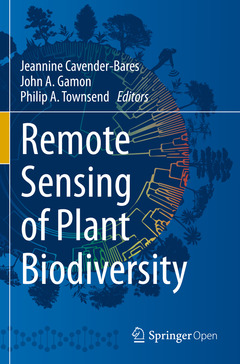Remote Sensing of Plant Biodiversity, 1st ed. 2020
Coordonnateurs : Cavender-Bares Jeannine, Gamon John A., Townsend Philip A.

This Open Access volume aims to methodologically improve our understanding of biodiversity by linking disciplines that incorporate remote sensing, and uniting data and perspectives in the fields of biology, landscape ecology, and geography. The book provides a framework for how biodiversity can be detected and evaluated?focusing particularly on plants?using proximal and remotely sensed hyperspectral data and other tools such as LiDAR. The volume, whose chapters bring together a large cross-section of the biodiversity community engaged in these methods, attempts to establish a common language across disciplines for understanding and implementing remote sensing of biodiversity across scales.
The first part of the book offers a potential basis for remote detection of biodiversity. An overview of the nature of biodiversity is described, along with ways for determining traits of plant biodiversity through spectral analyses across spatial scales and linking spectral data to the tree of life. The second part details what can be detected spectrally and remotely. Specific instrumentation and technologies are described, as well as the technical challenges of detection and data synthesis, collection and processing. The third part discusses spatial resolution and integration across scales and ends with a vision for developing a global biodiversity monitoring system. Topics include spectral and functional variation across habitats and biomes, biodiversity variables for global scale assessment, and the prospects and pitfalls in remote sensing of biodiversity at the global scale.
Chapter1. The use of remote sensing to enhance biodiversity monitoring & detection—a critical challenge for the 21st century. - Chapter2. Applying Remote Sensing to Biodiversity Science.- Chapter3. Scaling Functional Traits from Leaves to Canopies.- Chapter4. The Laegeren Site: An Augmented Forest Laboratory.- Chapter5. Lessons Learned from Spectranomics: Wet Tropical Forests.- Chapter6. Remote Sensing for Early, Detailed, and Accurate Detection of Forest Disturbance and Decline for Protection of Biodiversity.- Chapter7. Linking Leaf Spectra to the Plant Tree of Life.- Chapter8. Linking Foliar Traits to Belowground Processes.- Chapter9. Linking Foliar Traits to Belowground Processes.- Chapter9. Using Remote Sensing for Modeling and Monitoring Species Distributions.- Chapter10. Remote Sensing of Geodiversity as a Link to Biodiversity.- Chapter11. Predicting Patterns of Plant Diversity and Endemism in the Tropics Using Remote Sensing Data: A Study Case From the Brazilian Atlantic Forest.- Chapter12. Remote Detection of Invasive Alien Species.- Chapter13. A Range of Earth Observation Techniques for Assessing Plant Diversity.- Chapter14. How the Optical Properties of Leaves Modify the Absorption and Scattering of Energy and Enhance Leaf Functionality.- Chapter15. Spectral Field Campaigns: Planning and Data Collection.- Chapter16. Consideration of Scale in Remote Sensing of Biodiversity.- Chapter17. Integrating Biodiversity, Remote Sensing, and Auxiliary Information for the Study of Ecosystem Functioning and Conservation at Large Spatial Scales.- Chapter18. Essential Biodiversity Variables: Integrating in Situ Observations and Remote Sensing Through Modeling.- Chapter19. Prospects and pitfalls for spectroscopic remote sensing of biodiversity at the global scale.- Chapter20. Epilogue – Towards a Global Biodiversity Monitoring System.
Dr. Jeannine Cavender-Bares is a Professor in the Department of Ecology, Evolution and Behavior at the University of Minnesota. She earned a Masters at the Yale School of Forestry and Environmental Studies, and a PhD in Biology at Harvard University. Her research focuses on the ecology and evolution of plant function, applying phylogenetics and spectral data to community ecology, and remote sensing of biodiversity. She is committed to advancing international efforts for global monitoring and assessment of biodiversity and ecosystem services to aid management efforts towards sustainability.
Dr. John Gamon is a Professor in the Departments of Earth & Atmospheric Sciences and Biological Sciences at the University of Alberta. He also conducts research in Quantitative Remote Sensing at the Center for Advanced Land Management Information Technologies (CALMIT) in the School of Natural Resources at the University of Nebraska, Lincoln. He earned his Masters and his PhD in Botany at the University of California, Davis, and did his Post-Doctoral Research on Remote Sensing and Ecophysiology at the Carnegie institution in Stanford, CA. His research focus include photosynthesis, ecosystem function, productivity, biodiversity, ecoinformatics and sustainability.Dr. Philip Townsend is a Distinguished Professor in the Department of Forest and Wildlife Ecology at the University of Wisconsin, Madison. He earned his PhD in Geography at the University of North Carolina, Chapel Hill. His research focuses include physiological remote sensing, imaging spectroscopy, ecosystem ecology, and watershed hydrology.
Date de parution : 09-2020
Ouvrage de 581 p.
15.5x23.5 cm
Disponible chez l'éditeur (délai d'approvisionnement : 15 jours).
Prix indicatif 52,74 €
Ajouter au panierDate de parution : 06-2020
Ouvrage de 581 p.
15.5x23.5 cm
Thèmes de Remote Sensing of Plant Biodiversity :
Mots-clés :
Remote detection of biodiversity; Retrieving functional traits from spectra; Community assembly; Spectral diversity; Leaf optical properties; Hyperspectral field data collection and processing; Spatial resolution and integration across scales; Micro and macroscopic structure of leaves; Detection of disease and decline in forests; Ocean and aquatic biodiversity; Open Access; remote sensing/photogrammetry



